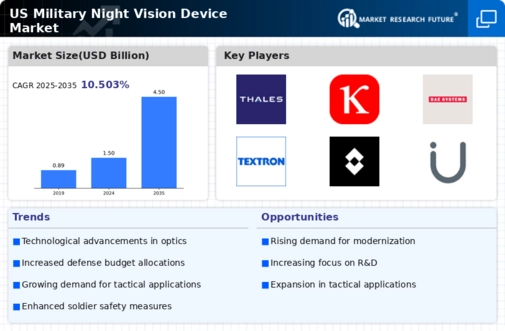Geopolitical Tensions
Geopolitical tensions in various regions are contributing to the growth of the military night-vision-device market. The U.S. military is increasingly focused on enhancing its operational readiness in response to potential threats from adversarial nations. This heightened state of alertness necessitates the acquisition of advanced night-vision technologies to ensure effective surveillance and reconnaissance capabilities. As military operations become more complex, the demand for reliable and high-performance night-vision devices is likely to rise. The ongoing conflicts and strategic competition in regions such as Eastern Europe and the Indo-Pacific are prompting defense agencies to prioritize investments in advanced optical technologies. Consequently, the military night-vision-device market is poised for expansion as defense forces adapt to the changing security landscape.
Rising Defense Budgets
The military night-vision-device market is experiencing growth due to increasing defense budgets across various branches of the U.S. military. In recent years, the U.S. government has allocated substantial funds to enhance military capabilities, with a focus on advanced technologies. For instance, the defense budget for FY 2025 is projected to exceed $800 billion, with a significant portion earmarked for modernization programs. This financial commitment is likely to drive demand for sophisticated night-vision devices, as military forces seek to maintain a technological edge. The emphasis on upgrading existing equipment and investing in next-generation systems suggests a robust market environment for night-vision technologies. As a result, manufacturers are expected to innovate and expand their product offerings to meet the evolving needs of the military night-vision-device market.
Integration of AI and Machine Learning
The integration of artificial intelligence (AI) and machine learning technologies into night-vision devices is transforming the military night-vision-device market. These advancements enable enhanced image processing, target recognition, and situational awareness, which are critical for modern military operations. The incorporation of AI algorithms allows for real-time data analysis, improving decision-making capabilities for military personnel. As the U.S. military seeks to leverage cutting-edge technologies, the demand for AI-enabled night-vision systems is expected to grow. This trend aligns with broader defense initiatives aimed at modernizing military capabilities and enhancing operational efficiency. The military night-vision-device market is likely to witness increased investment in research and development to create innovative solutions that integrate AI and machine learning, thereby addressing the evolving needs of defense forces.
Emerging Threats and Asymmetric Warfare
The military night-vision-device market is being shaped by the evolving nature of asymmetric warfare. As adversaries adopt unconventional tactics, the need for advanced surveillance and reconnaissance capabilities becomes paramount. Night-vision devices are essential tools for military forces to counter these threats effectively. The U.S. military is increasingly focused on developing technologies that can operate in diverse environments, including urban settings and challenging terrains. This shift in operational focus is likely to drive demand for versatile night-vision solutions that can adapt to various combat scenarios. As the military seeks to enhance its capabilities in countering asymmetric threats, the military night-vision-device market is expected to experience sustained growth, with an emphasis on innovation and adaptability.
Focus on Soldier Modernization Programs
The military night-vision-device market is significantly influenced by ongoing soldier modernization programs within the US armed forces. These initiatives aim to enhance the effectiveness and survivability of soldiers in the field by equipping them with advanced technologies. Night-vision devices play a crucial role in these programs, providing soldiers with enhanced visibility and situational awareness during nighttime operations. The U.S. Army's Integrated Visual Augmentation System (IVAS) program, for example, emphasizes the integration of night-vision capabilities into soldier systems. As these modernization efforts continue, the demand for innovative night-vision solutions is expected to rise, driving growth in the military night-vision-device market. The focus on improving soldier performance and safety underscores the importance of investing in advanced optical technologies.






















Leave a Comment